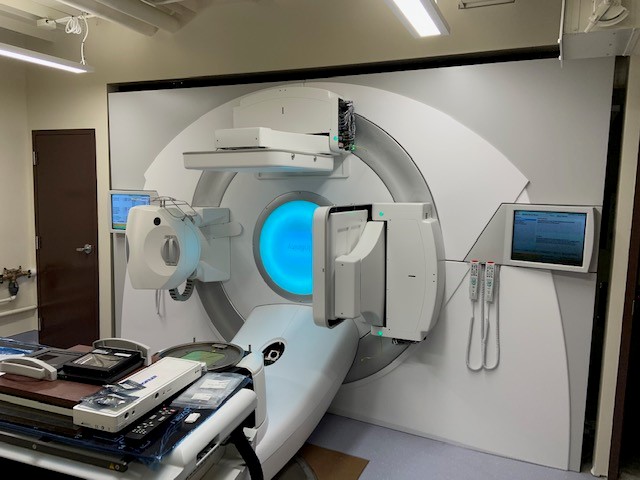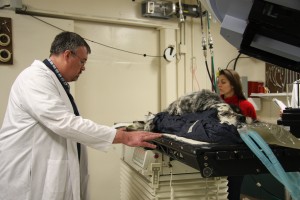
 Radiation therapy is used to treat localized disease. It can be used in the management of cancers that cannot be treated successfully by surgery or chemotherapy alone. Typically, it is employed following surgery when there are tumor cells remaining after excision, either because of the nature of tumor growth or because complete surgical removal would involve an extensive procedure involving vital structures. In some instances, radiation therapy may be employed before surgery or chemotherapy in an attempt to shrink a tumor to a more manageable size. In some instances, radiation therapy can offer permanent control of a tumor.
Radiation therapy is used to treat localized disease. It can be used in the management of cancers that cannot be treated successfully by surgery or chemotherapy alone. Typically, it is employed following surgery when there are tumor cells remaining after excision, either because of the nature of tumor growth or because complete surgical removal would involve an extensive procedure involving vital structures. In some instances, radiation therapy may be employed before surgery or chemotherapy in an attempt to shrink a tumor to a more manageable size. In some instances, radiation therapy can offer permanent control of a tumor.
Yes. In situations where it is unlikely that any one method of cancer treatment will be effective, such as large or aggressive tumors, radiation therapy can be combined with surgery or chemotherapy. In some situations a combination of all three types of treatment may be recommended.
Radiation therapy is typically given in a series of treatments that encompass several weeks. This schedule helps protect normal tissue by spreading out the total dose of radiation. The treatment area is designed to include all of the cancer and as little normal tissue as possible. The total dose used and the number of treatments depends on many factors. These factors include the size and location of the cancer (that is, which normal tissues will be within the treatment area), the general health of your pet and the type of cancer present. The most important consideration is the total amount of radiation that can be administered to a patient without compromising the ability of healthy tissue to heal. The treatment area may be marked with ink to enable the treatment to be directed to the same place every time.
At the Veterinary Health Center, most patients receive daily treatments Monday through Friday over 3 1/2 weeks. Outpatient treatments take about two hours. Because of the anesthesia required, outpatients should not be fed after 10 p.m. the night before treatments, but water may be provided throughout the night. Pets may be sleepy for several hours following each treatment.
Weekends are reserved as a rest period during which normal tissues have an opportunity to recover from the treatment. At times, more extensive rest periods are required. Patients may stay in the hospital during the weekends.
During treatment we will monitor the effect of the radiation on the cancer as well as on normal tissue. Most side effects that occur during radiation therapy, although unpleasant, are usually not serious, and are almost always limited to the area being treated. Many animals develop skin changes in the area being treated. A redness of the skin may develop near the end of, or after, radiation therapy. This may progress to a dry or moist skin reaction that resembles a severe sunburn or blistering rash. This “radiation dermatitis” may cause your pet to rub or scratch, but it is important you try to keep your pet from doing this. Your veterinarian may prescribe medication and/or physical means (such as an Elizabethan collar) to prevent rubbing and scratching. Hair loss in the treated area is common and may persist for some time, but regrowth occurs in many patients. The colors of the regrowing hair and skin in the treated area are likely to change.
It is unusual for animals to become nauseated and have vomiting/diarrhea as a result of radiation therapy. This will usually occur only if large portions of the abdomen are irradiated. Side effects involving other tissues that may be within the radiation treatment area (such as the eye, mucous membranes and bone) will be discussed with you on an individual basis. The time from first appearance of acute side effects (such as those that happen in the immediate treatment period) until their resolution is usually three to four weeks. Chronic side effects, when they occur, develop gradually over months to years. These includes fibrosis (scar tissue formation) and decreased ability to heal a wound or bone fracture. There is also a very small risk (less than 5 percent) of a secondary cancer within the radiation site years after treatment is administered.
In order to reduce the radiation dose to normal tissues, and maximize the dose to tumors, this therapy requires the animal to be perfectly still during treatment. Thus, anesthesia is necessary for each treatment. There is always a slight risk associated with anesthesia.
It is important for your veterinarian to examine your pet periodically after radiation therapy. This will allow your veterinarian to monitor normal tissue side effects and evaluate the effect of the radiation on the tumor. Specific follow-up schedules vary with each patient, but usually include a visit six to eight weeks after the completion of radiation. The goal of radiation therapy is to completely eradicate the cancer. In some pets this happens and no evidence of the tumor persists. In other pets the tumor may never completely disappear, but growth is stopped and the tumor is essentially controlled. The specific results to be expected depend on many factors. Details on the likelihood of success will be provided to you on an individual basis by the Oncology Service.



